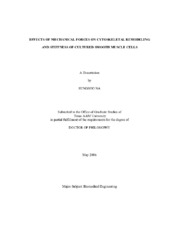| dc.description.abstract | The cytoskeleton is a diverse, multi-protein framework that plays a fundamental role in many cellular activities including mitosis, cell division, intracellular transport, cell motility, muscle contraction, and the regulation of cell polarity and organization. Furthermore, cytoskeletal filaments have been implicated in the pathogenesis of a wide variety of diseases including cancer, blood disease, cardiovascular disease, inflammatory disease, neurodegenerative disease, and problems with skin, nail, cornea, hair, liver and colon. Increasing evidence suggests that the distribution and organization of the cytoskeleton in living cells are affected by mechanical stresses and the cytoskeleton determines cell stiffness. We developed a fully nonlinear, constrained mixture model for adherent cells that allows one to account separately for the contributions of the primary structural constituents of the cytoskeleton and extended a prior solution from the finite elasticity literature for use in a sub-class of atomic force microscopy (AFM) studies of cell mechanics. The model showed that the degree of substrate stretch and the geometry of the AFM tip dramatically affect the measured cell stiffness. Consistent with previous studies, the model showed that disruption of the actin filaments can reduce the stiffness substantially, whereas there can be little contribution to the overall cell stiffness by the microtubules or intermediate filaments. To investigate the effect of mechanical stretching on cytoskeletal remodeling and cell stiffness, we developed a simple cell-stretching device that can be combined with an AFM and confocal microscopy. Results demonstrate that cyclic stretching significantly and rapidly alters both cell stiffness and focal adhesion associated vinculin and paxillin, suggesting that focal adhesion remodeling plays a critical role in cell stiffness by recruiting and anchoring F-actin. Finally, we estimated cytoskeletal remodeling by synthesizing data on stretch-induced dynamic changes in cell stiffness and focal adhesion area using constrained mixture approach. Results suggest that the acute increase in stiffness in response to an increased cyclic stretch was probably due to an increased stretch of the original filaments whereas the subsequent decrease back towards normalcy was consistent with a replacement of the highly stretched original filaments with less stretched new filaments. | en |


